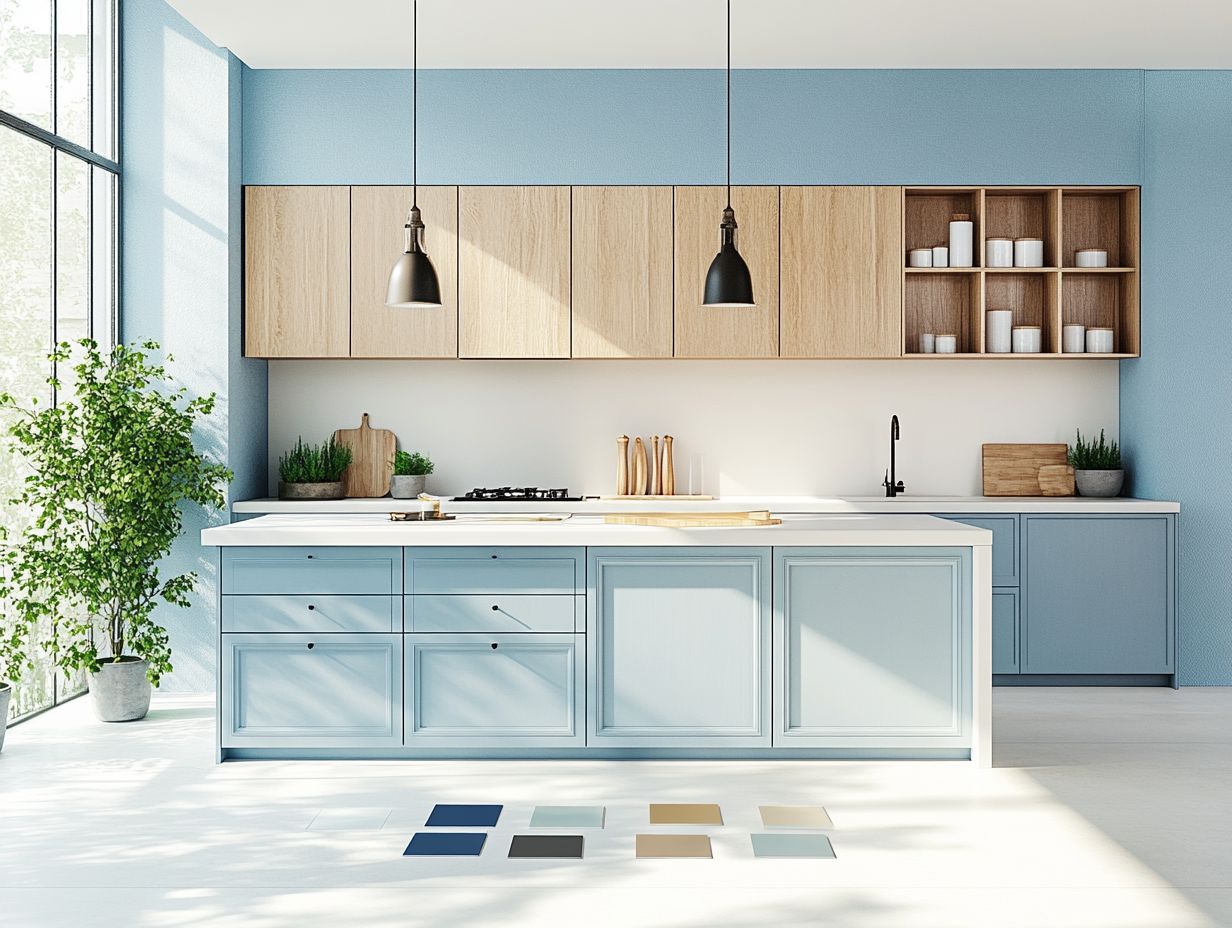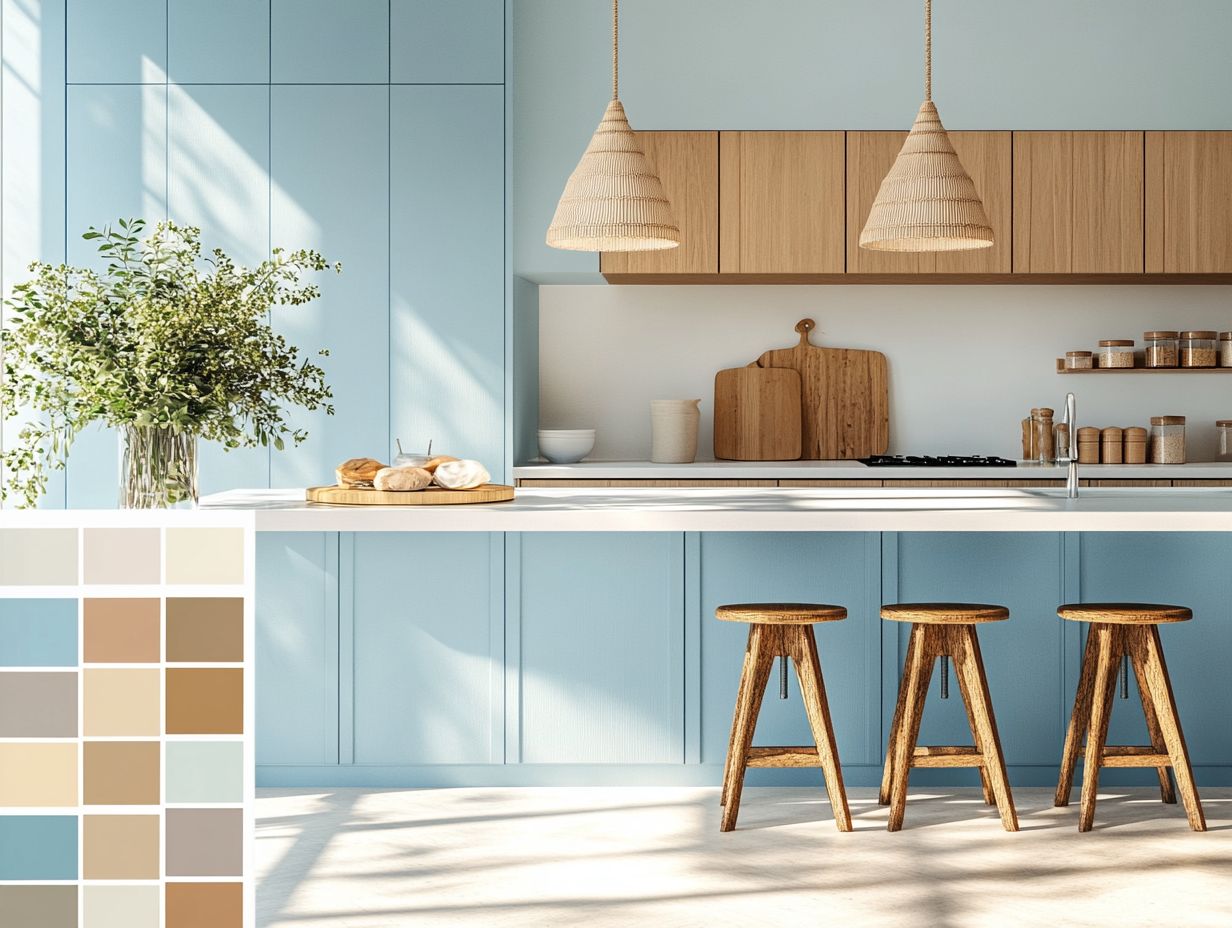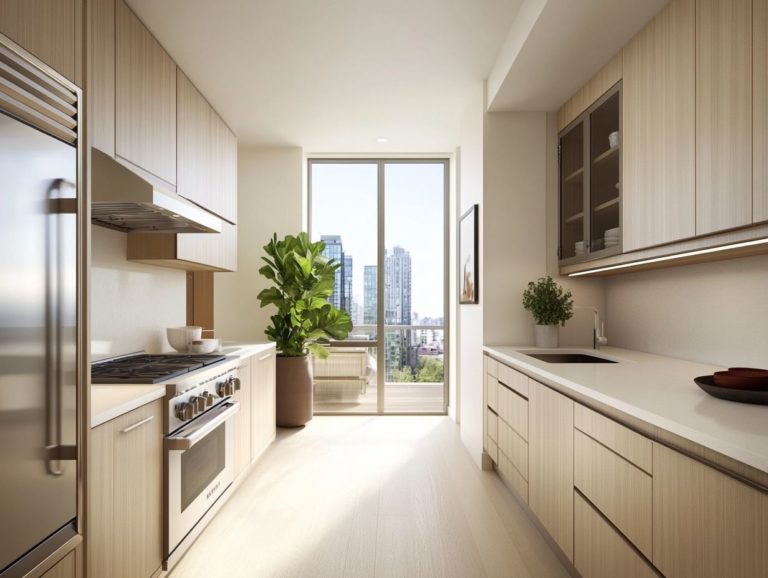5 Tips for Choosing the Right Kitchen Color Palette
Choosing the perfect color palette for your kitchen can transform the heart of your home. It allows your space to reflect your unique style while enhancing functionality.
You must think about several important factors that influence your selections. Consider the overall style and theme of your kitchen, along with how natural light interacts with your chosen colors. Each element plays an important role in the final outcome.
Let’s dive into five essential tips that will elevate your kitchen’s style! This guide will help you select the right colors, explore popular palettes, and avoid common pitfalls, ensuring your kitchen is not only beautiful but also inviting.
Contents
- Key Takeaways:
- 1. Consider the Overall Style and Theme
- 2. Look at the Natural Lighting in the Kitchen
- 3. Think About the Mood You Want to Create
- 4. Consider Your Existing Kitchen Elements
- 5. Dive into Color Experimentation
- What Are the Most Popular Kitchen Color Palettes?
- How Can Different Colors Affect the Perception of Space in the Kitchen?
- What Are Some Common Color Mistakes to Avoid in the Kitchen?
- How Can You Use Color to Create a Cohesive Look in the Kitchen?
- What Are Some Tips for Incorporating Bold Colors in the Kitchen?
- How Can You Use Color to Make Small Kitchens Appear Larger?
- Frequently Asked Questions
- What are the main factors to consider when choosing a kitchen color palette?
- Does the size of my kitchen affect the color palette I should choose?
- How much natural light should I take into consideration?
- What role do my personal style and preferences play in choosing a color palette?
- Should I consider the existing fixtures and appliances when choosing a color palette?
- Can I combine different colors in my kitchen color palette?
Key Takeaways:

Here’s what to remember:
- Consider the overall style and theme of your kitchen when choosing a color palette.
- Take into account the natural lighting in your kitchen for optimal color choices.
- Think about the mood you want to create and choose colors accordingly.
1. Consider the Overall Style and Theme
When you start a kitchen renovation, it’s essential to consider the style and theme that will define your space. This choice influences every detail, from the colors you select to the design of your cabinets and accessories.
A cohesive look requires a well-curated design palette that harmonizes with your home’s architectural character and reflects your personal taste. This ensures that the kitchen becomes a seamless extension of your living space.
By thoughtfully selecting colors that complement the existing architecture, you can create an inviting atmosphere that feels genuine. Balancing bold accents with a neutral base is vital to maintain visual interest without overwhelming your senses.
Incorporating elements such as textured finishes, varied cabinet styles, or distinctive hardware can add depth to your design. Whether you lean towards a calm hue or a vibrant shade, ensure these choices resonate with how you live and entertain.
2. Look at the Natural Lighting in the Kitchen
Natural lighting significantly influences how both light and dark shades are perceived throughout the day. With the sun’s position shifting, hues can take on different vibes at various times.
Consider these factors when selecting your color palette. A bright kitchen drenched in warm sunlight might make softer pastels feel inviting. Conversely, a north-facing room could benefit from warmer tones to counteract any chilliness.
Using reflective surfaces like glossy backsplashes or polished countertops can boost natural light. Colors such as soft whites or light grays create a sense of spaciousness, which is vital, especially in smaller kitchens.
3. Think About the Mood You Want to Create
Understanding color psychology is important when choosing hues for your kitchen. Color psychology refers to how different colors can affect your feelings and behavior. The colors you select can evoke different moods, transforming your space into either a cozy retreat or a vibrant gathering area.
Warm tones like reds and oranges cultivate an inviting and energetic environment, making them ideal for family meals. These colors stimulate conversation and enhance your appetite, perfect for spaces where meals are prepared and shared.
On the flip side, cooler colors such as blues and greens promote calmness and relaxation, providing a serene backdrop for daily kitchen activities. Don’t underestimate the power of color combinations; the balance between bold hues and softer shades plays a significant role in the room’s visual cohesion.
With thoughtful planning, you can curate an atmosphere that reflects your personal style, elevating both the functionality and aesthetic appeal of your kitchen.
Start your kitchen transformation today!
4. Consider Your Existing Kitchen Elements

When planning your kitchen design, it’s essential to consider your existing elements, like cabinets and appliances. These will significantly influence your color choices and overall color scheme.
These components serve as a backdrop that guides your decisions. They help the new color palette resonate with the room’s vibe. For instance, when selecting cabinet colors, look for shades that harmonize with your countertop materials or backsplash tiles.
This creates a cohesive look. Imagine how your cabinet colors can complement your hardware! Consider how the hues of your cabinet doors interact with the metallic finishes of your hardware and the tones in your other kitchen accessories.
This thoughtful approach to color selection enhances aesthetic appeal and fosters an inviting atmosphere, perfect for gatherings or cozy family meals.
5. Dive into Color Experimentation
Dive into the world of color! Experimenting with bold hues can turn your kitchen into a stunning showcase. Integrate vivid shades that make a striking statement and enhance visual interest.
Explore current color trends to discover how even small changes can invigorate the heart of your home. Imagine cheerful yellows paired with elegant grays or lively greens against warm wood tones—there are endless possibilities.
Mix playful accents like colorful backsplash tiles or bright cabinet finishes to infuse personality without overwhelming the space. Incorporating design elements such as vibrant dishware or decorative kitchen towels can serve as bright spots of color that enliven the atmosphere.
With a thoughtful approach to color combinations, your kitchen can transform into a creative canvas that reflects your style and enhances the joy of cooking and entertaining.
What Are the Most Popular Kitchen Color Palettes?
Popular kitchen color palettes often blend warm and cool tones, creating unique aesthetics tailored to various styles—from modern chic to classic traditional. Carefully consider these color combinations to achieve a stylish kitchen design.
Warm colors like rich reds and sunny yellows can transform your space into an inviting haven, perfect for family gatherings and culinary adventures. In contrast, darker hues like deep navy or charcoal exude sophistication and elegance, infusing your kitchen with depth and drama.
If you’re aiming for a brighter ambiance, light color palettes featuring soft pastels or fresh whites can instantly uplift the room, making it feel airy and spacious.
Contemporary trends often gravitate toward earthy tones and neutral shades, offering a timeless appeal that complements various decor choices. These selections enhance visual charm and elevate the functionality of today’s kitchens, making them practical and beautiful.
How Can Different Colors Affect the Perception of Space in the Kitchen?
Different colors can dramatically influence your perception of kitchen space. Light shades create an airy, expansive feel, while darker tones add depth and visual intrigue.
Choose wisely based on the atmosphere you wish to cultivate. The psychological impact of your color choices significantly shapes your experience in the kitchen.
For example, soft pastels or crisp whites foster a sense of lightness, creating an open and inviting environment ideal for cooking and socializing. Deep hues like navy or charcoal can evoke a cozy ambiance but may also make the space feel more enclosed.
Even subtle colors like pale blue can visually extend your horizon, while vibrant accents can serve as captivating focal points. These choices influence both perception and functionality in your culinary haven.
What Are Some Common Color Mistakes to Avoid in the Kitchen?

Common color mistakes in kitchen design can easily derail your intended look and function. For instance, opting for dark cabinets without balancing them with lighter shades can overwhelm the space.
Neglecting to consider the overall design theme when selecting hues can result in jarring contrasts that clash with your existing appliances and fixtures. Imagine pairing bold colors without complementary elements; you could create a look that feels chaotic instead of achieving the serene atmosphere most homeowners desire.
To create harmony, consider the size of your kitchen, natural light, and the mood you want. Thoughtful color selections—like a mix of soft colors that don’t stand out too much with vibrant decor—can enhance your space, ensuring that every detail feels beautifully connected.
How Can You Use Color to Create a Cohesive Look in the Kitchen?
Creating a cohesive look in your kitchen requires thoughtful color combinations and a harmonious blend of design elements—from cabinets and walls to accessories that fit together.
To achieve that color harmony, consider adopting a limited color palette. Choose two to three main colors that work well together. This approach creates a neat look where everything fits together, from your countertops to your hardware.
For example, pairing a soft blue with warm wood tones and crisp whites can evoke a serene, beachy atmosphere, while variations of gray with black and gold accents can add a touch of modern elegance.
By using carefully chosen colors, you ensure that everything from your tile choices to your dishware feels intentional, resulting in a kitchen that not only looks stunning but also functions beautifully.
What Are Some Tips for Incorporating Bold Colors in the Kitchen?
Incorporating bold colors in your kitchen can truly infuse energy and personality into the space, but it requires careful consideration to ensure these vibrant tones enhance rather than overwhelm your overall design.
To achieve a harmonious look, start by using bold colors as accent tones—think striking backsplashes or vividly colored kitchen accessories.
Combining these lively tones with muted colors can create a balanced palette that keeps your kitchen welcoming and visually appealing. For example, a rich navy or vibrant mustard can complement soft gray or white cabinetry, adding depth without chaos.
By mixing these colors carefully, you can evoke a sense of vitality and style, ultimately creating a kitchen that feels both energetic and cohesive.
How Can You Use Color to Make Small Kitchens Appear Larger?
Using color strategically can profoundly influence how you perceive your small kitchen. Light colors are essential in enhancing that spacious feel and overall visual appeal.
When selecting shades for your walls and cabinets, consider choosing soft pastels or crisp whites. These choices help bounce light around the space, creating an open and airy atmosphere.
You might also want to incorporate gentle contrasts, like a slightly darker hue for accents such as shelves or the backsplash. This adds depth without overwhelming your senses.
Limiting your color palette to two or three complementary tones is beneficial; it fosters a cohesive design that feels organized and seamless.
Thoughtful combinations of colors not only enhance the illusion of space but also invite a sense of tranquility into the bustling heart of your home.
Frequently Asked Questions

What are the main factors to consider when choosing a kitchen color palette?
The main factors to consider are the size and layout of your kitchen, the amount of natural light it receives, your personal style and preferences, the existing fixtures and appliances, and the overall aesthetic you want to achieve.
Get excited about your kitchen! Dive into choosing your colors today to transform your kitchen into the space of your dreams!
Does the size of my kitchen affect the color palette I should choose?
Yes, your kitchen’s size significantly impacts your color choices. Lighter shades can make smaller kitchens feel larger, while bigger kitchens can accommodate darker, bolder colors.
How much natural light should I take into consideration?
Natural light influences how colors appear in your kitchen. If your kitchen has little light, opt for lighter colors to brighten the space.
What role do my personal style and preferences play in choosing a color palette?
Your style is crucial when selecting a color palette for your kitchen. You should choose colors that bring you joy and reflect who you are.
Should I consider the existing fixtures and appliances when choosing a color palette?
Yes, consider your fixtures and appliances when deciding on colors. If you have a bold appliance, neutral tones may work best to prevent clashing.
Can I combine different colors in my kitchen color palette?
Absolutely! Mixing colors can add depth and interest to your kitchen. Just ensure that the colors go well together for a harmonious look.




